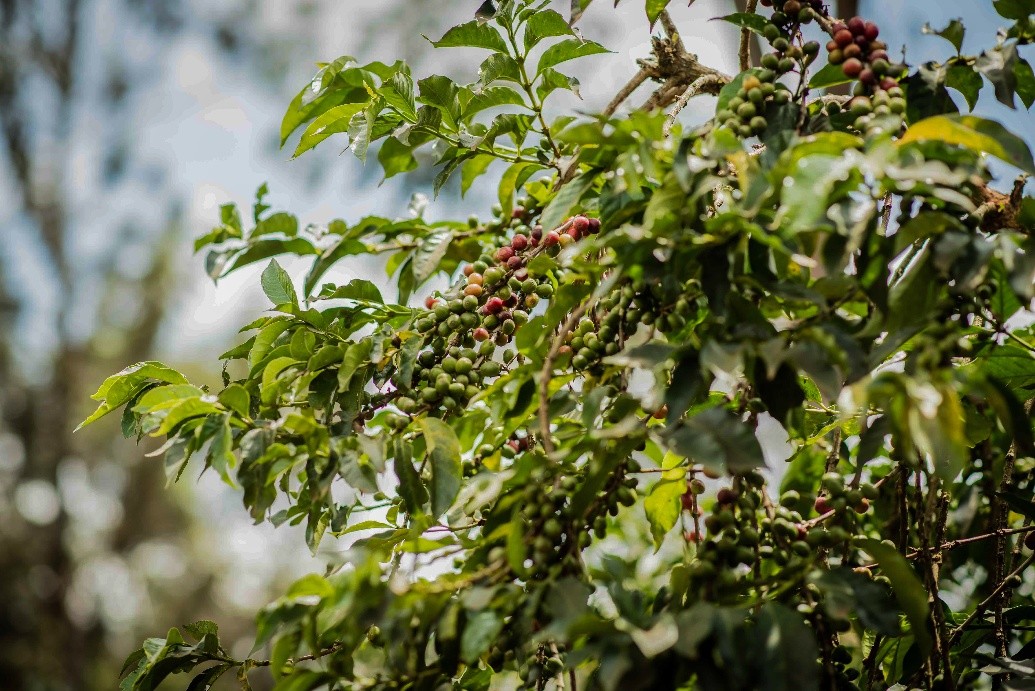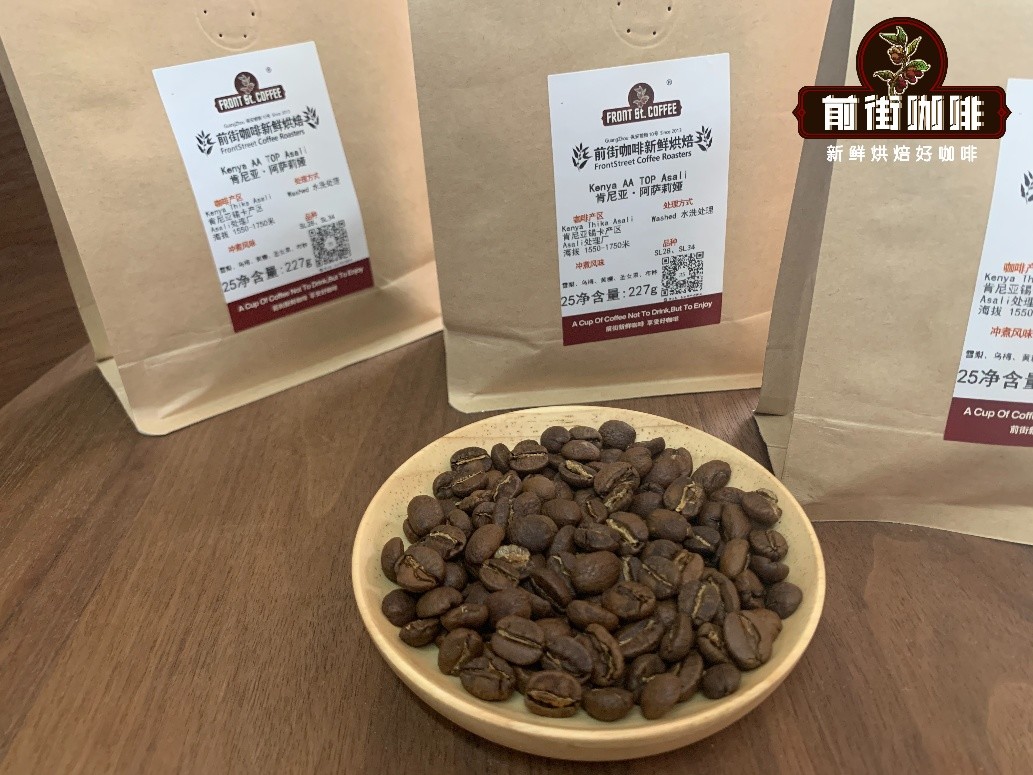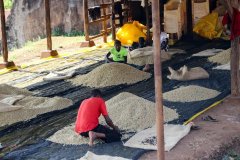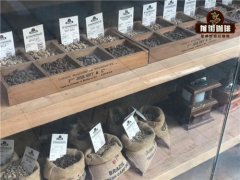Kenya Coffee Bean Fruit acquisition and Refining processing Mode | description of SL28 and SL34 flavor and taste
African coffee has always been one of the best coffee producing areas in the world. Kenya, as a country that pays attention to coffee cultivation and quality management, needless to say the flavor of coffee beans. So what kind of management model makes it develop so rapidly? / I believe everyone is very curious about its coffee fruit acquisition and meticulous processing plan!

First, the manor coffee farmers pick ripe fruits and send them to the washing station one after another.
Second, fresh fruit screening (cherry sorting). Before receiving the fruit, there will be an open space for coffee farmers to reclassify and select the ripe red fruit.
Third, five categories of coffee fruits. Remind coffee farmers that only red fruits with ticks will be accepted.
Weigh and reclaim the documents. Many washing stations are equipped with electronic floor scales, which can directly connect the weighing results to the computer and directly print the coffee farmer's code and the batch weight. The coffee farmer used the document
As the basis for future settlement.
Fifth, fresh fruit dou / warehouse (cherry hopper). The funnel-shaped receiving pool for receiving cherries is connected to the peeling machine at the bottom, and the coffee fruit begins to be refined by washing.
6. The peel of the coffee fruit from the peeling machine has been removed. At this stage, the machine will divert the fruit directly into two different channels according to the density. P1 with the highest density and P2 with medium density, and P3 with the lightest density are in different fermentation tanks.
7. The fermentation time of shell beans in the fermentation tank is about 12-36 hours. the fermentation time depends on the local weather, and the final time is the shedding of the pectin layer.
Eighth, after the end of fermentation, the shell bean is led to another tank and soaked in clean water, which is called static fine soaking, and the rest time depends on whether any impurities still emerge (or whether the water appears alone). If there is damp and turbid, you must change clean water. This step technique is the focus of Kenya's famous double fermentation or Kenyan washing method. The time depends on whether the rest is clean or whether the sun rack at the back is crowded, all for 12-36 hours.
9. Channel cleaning. After the completion of fermentation and static setting, people with shell bean flow clean channels, and there are devices with high and low water level difference at the bottom of most channels, which will stop those with higher density and lead them to other scaffolding areas, and those with lower density will be introduced into scaffolding areas of secondary quality.
Shell beans received by the cleaning channel mouth. This area is called Skin Dry scaffolding and belongs to the drainage zone. Usually, most of the water on the surface of shell beans is moved directly to the sun shed area after being dried, and then insolated.
Eleven, the stage of sun drying. The drying time depends on the local weather and whether the moisture content of shell beans reaches 10.5%-11%. It takes 7-14 days, or as long as 20 days.
12. Sun finish the warehouse (the warehouse of the washing station itself, also known as the transit warehouse).
XIII. Classification of dry treatment. After shelling, the beans are graded according to the size of the beans. The picture shows four grades E, AA, PB and F of the Thika dry treatment field.
Fourteen, distinguish a higher grade according to the density of beans. If the density of AA is too low, it is directly assigned to the PB level at this stage, as shown in the following figure (figure 14).
The logo of raw beans. As can be seen from top to bottom (figure 15), the grade of this bag of Kenyan raw beans is AB, the batch code is 19TK0048, and the year of production is 2016-2017.
Qianjie is here to introduce a coffee bean (Asali TopAA) from Asaria.

In 1878, the British made coffee available in Africa. Coffee plantations were established in Kenya in the 19th century, when Ethiopian coffee drinks were imported into Kenya through southern Yemen. Kenya in East Africa
At that time, Ethiopian coffee drinks were imported into Kenya via Nanya. But it was not until the early 20 th century that the Bourbon Coffee Tree was saint. The Austin mission (St. Aust inMission) was introduced into Kenya
Kenya, located in East Africa, is one of the major coffee producing countries. More than 6 million people in the country are engaged in the coffee industry, mostly in the form of a combination of small farmers and cooperatives. Coffee trees in Kenya are mostly planted at 1400-2000 meters above sea level.
The growth region includes Ruiri, Thika, Kirinyaga, Mt. Kenya West, Nyeri, Kiambu and Muranga. With Mt. The foothills of Kenya and Aberdare are mainly. The seed ministry's Mount Kirinaga (Mount Kenya), which is 5199 meters above sea level, grows in Manya Tahnbu County on the eastern slopes of the Kenyan Mountains between 1550 and 1750. The red soil in this area gives birth to coffee from Kenya's top-aa, which is the main crop. Common cooperatives made up of small farmers are more common than large manors. Coffee in TOPAA season is usually of high quality.
◎ bourbon variants (SL-28) and (SL-34) ◎
The two variants of SL-28 and SL-34 were created by the Scott Lab (Guy). Gibson led the research project to produce two of the 40 experimental varieties that have been auctioned by expert cups to test Narobi. The victorious army.
Coupled with the large temperature difference between day and night, and Kenya's red phosphate soil, sweet and sour has become the main flavor tone of Kenya.
Beans have a great sense of sweetness, balance and complex flavor, as well as remarkable characteristics of citrus and black plum
◎ Kenya 72-hour fermentation water washing treatment method ◎
Kenyan style originated in Kenya and washed after fermentation. After harvesting, high-quality cherries were selected for peeling and fermentation. The fermentation time was 24 hours and washed with clean river water after 24 hours. Then, it is fermented again with clean river water for 24 hours, then washed, and after 3 cycles, it reaches 72 hours, so it is called Kenyan 72-hour fermentation water washing treatment, referred to as [K72].
Determination of flavor by ◎ cup ◎
There is the acid of lemon and the sweetness and bitterness of dried plum
The aroma of flowers is mixed with the flavor of fruits such as apples.
The sweet and sour finish of plum juice and preserved fruit has the sweetness of caramel.
Important Notice :
前街咖啡 FrontStreet Coffee has moved to new addredd:
FrontStreet Coffee Address: 315,Donghua East Road,GuangZhou
Tel:020 38364473
- Prev

Six Coffee Bean producing areas in Kenya | Coffee treatment and different flavor and taste characteristics of different producing areas
Kenya is famous for its washed beans. Although there have been a small number of pure sun-dried beans and honey treatment sites in recent years, Kenya has traditionally focused on selling fruits, and it is difficult to persuade coffee farmers to participate in refining or change trading habits, so almost all refining is done by washing stations. 55% of Kenya's coffee is produced by 700000 small farmers and sent to their small cooperatives for refined processing, with the rest
- Next

Kenyan coffee bean grading standard| Kenya coffee packaging elephant logo and main growing areas
Kenya, like its neighbor Ethiopia, is a very important coffee-producing country. It is located in the middle of the equator at low latitudes, multi-plateau territory, an average altitude of 1500 meters, coffee is mainly planted in the capital Nairobi to Kenya mountains around the volcano at an altitude of 1600-2100 meters. This height is suitable for coffee beans to develop flavor, because mountain temperatures are lower and coffee grows
Related
- Detailed explanation of Jadeite planting Land in Panamanian Jadeite Manor introduction to the grading system of Jadeite competitive bidding, Red bid, Green bid and Rose Summer
- Story of Coffee planting in Brenka region of Costa Rica Stonehenge Manor anaerobic heavy honey treatment of flavor mouth
- What's on the barrel of Blue Mountain Coffee beans?
- Can American coffee also pull flowers? How to use hot American style to pull out a good-looking pattern?
- Can you make a cold extract with coffee beans? What is the right proportion for cold-extracted coffee formula?
- Indonesian PWN Gold Mandrine Coffee Origin Features Flavor How to Chong? Mandolin coffee is American.
- A brief introduction to the flavor characteristics of Brazilian yellow bourbon coffee beans
- What is the effect of different water quality on the flavor of cold-extracted coffee? What kind of water is best for brewing coffee?
- Why do you think of Rose Summer whenever you mention Panamanian coffee?
- Introduction to the characteristics of authentic blue mountain coffee bean producing areas? What is the CIB Coffee Authority in Jamaica?

